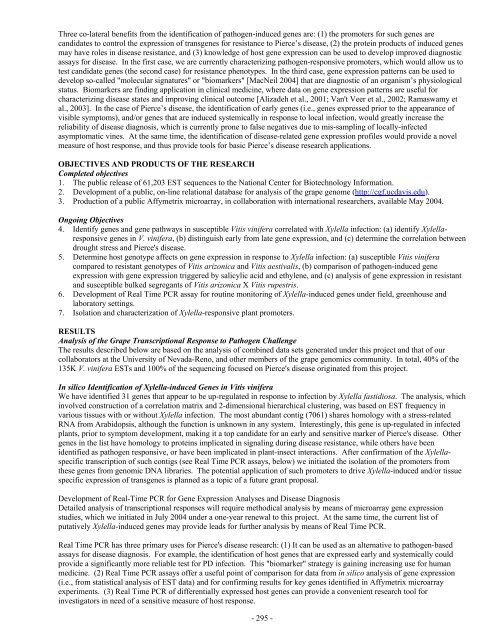Impact Of Host Plant Xylem Fluid On Xylella Fastidiosa Multiplication ...
Impact Of Host Plant Xylem Fluid On Xylella Fastidiosa Multiplication ...
Impact Of Host Plant Xylem Fluid On Xylella Fastidiosa Multiplication ...
Create successful ePaper yourself
Turn your PDF publications into a flip-book with our unique Google optimized e-Paper software.
Three co-lateral benefits from the identification of pathogen-induced genes are: (1) the promoters for such genes are<br />
candidates to control the expression of transgenes for resistance to Pierce’s disease, (2) the protein products of induced genes<br />
may have roles in disease resistance, and (3) knowledge of host gene expression can be used to develop improved diagnostic<br />
assays for disease. In the first case, we are currently characterizing pathogen-responsive promoters, which would allow us to<br />
test candidate genes (the second case) for resistance phenotypes. In the third case, gene expression patterns can be used to<br />
develop so-called "molecular signatures" or "biomarkers" [MacNeil 2004] that are diagnostic of an organism’s physiological<br />
status. Biomarkers are finding application in clinical medicine, where data on gene expression patterns are useful for<br />
characterizing disease states and improving clinical outcome [Alizadeh et al., 2001; Van't Veer et al., 2002; Ramaswamy et<br />
al., 2003]. In the case of Pierce’s disease, the identification of early genes (i.e., genes expressed prior to the appearance of<br />
visible symptoms), and/or genes that are induced systemically in response to local infection, would greatly increase the<br />
reliability of disease diagnosis, which is currently prone to false negatives due to mis-sampling of locally-infected<br />
asymptomatic vines. At the same time, the identification of disease-related gene expression profiles would provide a novel<br />
measure of host response, and thus provide tools for basic Pierce’s disease research applications.<br />
OBJECTIVES AND PRODUCTS OF THE RESEARCH<br />
Completed objectives<br />
1. The public release of 61,203 EST sequences to the National Center for Biotechnology Information.<br />
2. Development of a public, on-line relational database for analysis of the grape genome (http://cgf.ucdavis.edu).<br />
3. Production of a public Affymetrix microarray, in collaboration with international researchers, available May 2004.<br />
<strong>On</strong>going Objectives<br />
4. Identify genes and gene pathways in susceptible Vitis vinifera correlated with <strong>Xylella</strong> infection: (a) identify <strong>Xylella</strong>responsive<br />
genes in V. vinifera, (b) distinguish early from late gene expression, and (c) determine the correlation between<br />
drought stress and Pierce's disease.<br />
5. Determine host genotype affects on gene expression in response to <strong>Xylella</strong> infection: (a) susceptible Vitis vinifera<br />
compared to resistant genotypes of Vitis arizonica and Vitis aestivalis, (b) comparison of pathogen-induced gene<br />
expression with gene expression triggered by salicylic acid and ethylene, and (c) analysis of gene expression in resistant<br />
and susceptible bulked segregants of Vitis arizonica X Vitis rupestris.<br />
6. Development of Real Time PCR assay for routine monitoring of <strong>Xylella</strong>-induced genes under field, greenhouse and<br />
laboratory settings.<br />
7. Isolation and characterization of <strong>Xylella</strong>-responsive plant promoters.<br />
RESULTS<br />
Analysis of the Grape Transcriptional Response to Pathogen Challenge<br />
The results described below are based on the analysis of combined data sets generated under this project and that of our<br />
collaborators at the University of Nevada-Reno, and other members of the grape genomics community. In total, 40% of the<br />
135K V. vinifera ESTs and 100% of the sequencing focused on Pierce's disease originated from this project.<br />
In silico Identification of <strong>Xylella</strong>-induced Genes in Vitis vinifera<br />
We have identified 31 genes that appear to be up-regulated in response to infection by <strong>Xylella</strong> fastidiosa. The analysis, which<br />
involved construction of a correlation matrix and 2-dimensional hierarchical clustering, was based on EST frequency in<br />
various tissues with or without <strong>Xylella</strong> infection. The most abundant contig (7061) shares homology with a stress-related<br />
RNA from Arabidopsis, although the function is unknown in any system. Interestingly, this gene is up-regulated in infected<br />
plants, prior to symptom development, making it a top candidate for an early and sensitive marker of Pierce's disease. Other<br />
genes in the list have homology to proteins implicated in signaling during disease resistance, while others have been<br />
identified as pathogen responsive, or have been implicated in plant-insect interactions. After confirmation of the <strong>Xylella</strong>specific<br />
transcription of such contigs (see Real Time PCR assays, below) we initiated the isolation of the promoters from<br />
these genes from genomic DNA libraries. The potential application of such promoters to drive <strong>Xylella</strong>-induced and/or tissue<br />
specific expression of transgenes is planned as a topic of a future grant proposal.<br />
Development of Real-Time PCR for Gene Expression Analyses and Disease Diagnosis<br />
Detailed analysis of transcriptional responses will require methodical analysis by means of microarray gene expression<br />
studies, which we initiated in July 2004 under a one-year renewal to this project. At the same time, the current list of<br />
putatively <strong>Xylella</strong>-induced genes may provide leads for further analysis by means of Real Time PCR.<br />
Real Time PCR has three primary uses for Pierce's disease research: (1) It can be used as an alternative to pathogen-based<br />
assays for disease diagnosis. For example, the identification of host genes that are expressed early and systemically could<br />
provide a significantly more reliable test for PD infection. This "biomarker" strategy is gaining increasing use for human<br />
medicine. (2) Real Time PCR assays offer a useful point of comparison for data from in silico analysis of gene expression<br />
(i.e., from statistical analysis of EST data) and for confirming results for key genes identified in Affymetrix microarray<br />
experiments. (3) Real Time PCR of differentially expressed host genes can provide a convenient research tool for<br />
investigators in need of a sensitive measure of host response.<br />
- 295 -











